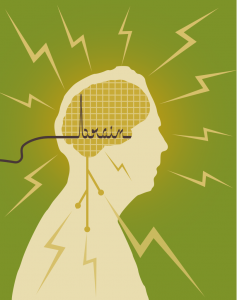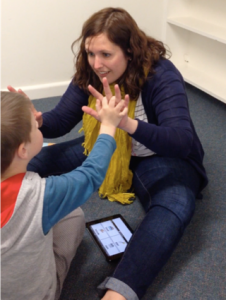Guest Blog: Amarie Carnett, Ph.D., BCBA-D, LBA
Senior Lecturer, Victoria University of Wellington
“Any sufficiently advanced technology is indistinguishable from magic” – Arthur C. Clarke
As our world rapidly progresses within the realm of technology, we frequently find ourselves behind in application. Often, clearly established “best practice” has yet to be determined, and the science lags behind our clinical practices.
 Recent advancement in technology and the application to verbal behavior has me both excited and optimistic about our future. For example, recent research published in Nature (Anumanchipalli, Chartier, & Chang, 2019) shows how technology can translate brain activity into digitized speech. Although we are probably years away from the application of this advanced neurotechnology for individuals with disabilities, I am hopeful that this technological advancement can help improve our speech-generating technology. Just think about the implications and possibilities for technology that transmit covert (thinking) behavior into digitized speech! It’s truly mind-blowing and sounds like magic to my ears. For now, let’s visit the current state of the technology used in the land of speech-generating devices (SGDs). DISCAIMER: this is in no way a comprehensive review. These are merely some of my current thoughts on this topic.
Recent advancement in technology and the application to verbal behavior has me both excited and optimistic about our future. For example, recent research published in Nature (Anumanchipalli, Chartier, & Chang, 2019) shows how technology can translate brain activity into digitized speech. Although we are probably years away from the application of this advanced neurotechnology for individuals with disabilities, I am hopeful that this technological advancement can help improve our speech-generating technology. Just think about the implications and possibilities for technology that transmit covert (thinking) behavior into digitized speech! It’s truly mind-blowing and sounds like magic to my ears. For now, let’s visit the current state of the technology used in the land of speech-generating devices (SGDs). DISCAIMER: this is in no way a comprehensive review. These are merely some of my current thoughts on this topic.
Speech-Generating Apps
 Overall, I would say we are in a good place regarding the technology and programming potential available for speech-generating apps. However, I must admit, I’m not a big fan of some of the premade templates that utilize core vocabulary for beginners. I find that it’s best to start with specified requests or mands for preferred items and activities before moving on to vocabulary that requires conditional discrimination[1] and such. Lately, when I have programmed a device, I remove all of the pre-programmed items and begin with a preference assessment to help determine what pictures/symbols will first be taught. Generally, I find it valuable to take a learner-specific approach when working with symbolic/picture-based systems. This approach is vital for a few reasons. Firstly, it helps to account for the learner’s motivating operation (MO), which is essential when teaching mands. Secondly, it helps to condition communication as a reinforcer. If a speaker is motivated by the symbols/items programmed on their device, then they are more likely to engage in verbal behavior with a listener. For individuals whose verbal behavior is not reinforced initially by social opportunities or have yet to contact this type of reinforcement, this is an important consideration to take into account. This is why mands are always an important place to start when teaching a verbal behavior repertoire. The social interaction that occurs between a speaker and a listener in this context can become conditioned social reinforcement[2] and make communication, in general, more socially reinforcing and enjoyable for the speaker.
Overall, I would say we are in a good place regarding the technology and programming potential available for speech-generating apps. However, I must admit, I’m not a big fan of some of the premade templates that utilize core vocabulary for beginners. I find that it’s best to start with specified requests or mands for preferred items and activities before moving on to vocabulary that requires conditional discrimination[1] and such. Lately, when I have programmed a device, I remove all of the pre-programmed items and begin with a preference assessment to help determine what pictures/symbols will first be taught. Generally, I find it valuable to take a learner-specific approach when working with symbolic/picture-based systems. This approach is vital for a few reasons. Firstly, it helps to account for the learner’s motivating operation (MO), which is essential when teaching mands. Secondly, it helps to condition communication as a reinforcer. If a speaker is motivated by the symbols/items programmed on their device, then they are more likely to engage in verbal behavior with a listener. For individuals whose verbal behavior is not reinforced initially by social opportunities or have yet to contact this type of reinforcement, this is an important consideration to take into account. This is why mands are always an important place to start when teaching a verbal behavior repertoire. The social interaction that occurs between a speaker and a listener in this context can become conditioned social reinforcement[2] and make communication, in general, more socially reinforcing and enjoyable for the speaker.
Some Recommendations
 As far as devices are concerned, there are applications for all types of touch screen technology ranging from AppleÒ products to AndroidÒ devices. There are now even cloud-based SGD apps that allow for programming by logging on through a different computer, so you can avoid taking the device from the child (see Cough Drop app). For SGD apps, I suggest finding one that offers both easy programming for therapists, parents, teachers, etc., and allows for continued complexity and growth of the repertoire (see Cough Drop, Talk Tablet, Proloquo2Go, just to name a few). This will help with the feasibility and sustainability of use.
As far as devices are concerned, there are applications for all types of touch screen technology ranging from AppleÒ products to AndroidÒ devices. There are now even cloud-based SGD apps that allow for programming by logging on through a different computer, so you can avoid taking the device from the child (see Cough Drop app). For SGD apps, I suggest finding one that offers both easy programming for therapists, parents, teachers, etc., and allows for continued complexity and growth of the repertoire (see Cough Drop, Talk Tablet, Proloquo2Go, just to name a few). This will help with the feasibility and sustainability of use.
Collaboration is Key
 One area that warrants discussion is the need to work with multi-collaborators when using SGDs. This can present challenges in what device (app) is selected, how the device is set up, and the teaching approaches that may be used. Thus, we must rely on assessment driven decisions, and utilize evidence-based teaching procedures. The notion that augmentative and alternative communication or SGDs are categorized as an evidence-based practice (EBP) in and of themselves is misleading. I have seen a little confusion in this area. For example, just because a child was evaluated and received a speech-generating device, does not mean I have employed the use of an EBP. It is almost always the case that this child would need systematic teaching procedures to develop a verbal behavior repertoire – at least initially. This continued access to systematic teaching procedures is essential to aid the progress towards a repertoire that includes multiple verbal operants (i.e., tacts, intraverbals). However, as our synthesis and analysis of research continues to progress, I am hopeful we will see clarification through outlets like What Works Clearinghouse, the National Autism Center, and National Professional Development Center on Autism Spectrum Disorder, with regards to the types of instructional practices that have an evidence-based for individuals who are learning to use SGDs.
One area that warrants discussion is the need to work with multi-collaborators when using SGDs. This can present challenges in what device (app) is selected, how the device is set up, and the teaching approaches that may be used. Thus, we must rely on assessment driven decisions, and utilize evidence-based teaching procedures. The notion that augmentative and alternative communication or SGDs are categorized as an evidence-based practice (EBP) in and of themselves is misleading. I have seen a little confusion in this area. For example, just because a child was evaluated and received a speech-generating device, does not mean I have employed the use of an EBP. It is almost always the case that this child would need systematic teaching procedures to develop a verbal behavior repertoire – at least initially. This continued access to systematic teaching procedures is essential to aid the progress towards a repertoire that includes multiple verbal operants (i.e., tacts, intraverbals). However, as our synthesis and analysis of research continues to progress, I am hopeful we will see clarification through outlets like What Works Clearinghouse, the National Autism Center, and National Professional Development Center on Autism Spectrum Disorder, with regards to the types of instructional practices that have an evidence-based for individuals who are learning to use SGDs.
[1] Conditional discrimination is a discrimination in which reinforcement for responding is conditional upon 2 or more stimuli. For a child using symbolic communication, it could be tested with a simple correspondence check. For example, if a child was learning to mand for pretzels and popcorn using an SGD, upon selecting the symbol POPCORN, the therapist could hold up both items to see what they child takes. If the child consistently takes the correct item that corresponds with the symbol they activated on their device, it is likely they have conditional discrimination of those two food items in the context of manding.
[2] A generalized social reinforcer is a stimulus (e.g., social attention) that was once neutral and is paired with another reinforcing stimuli to gain associative properties. For example, if a child is learning how to mand for their favorite toy when the listener that delivers the toy the child mands for, they might also smile and deliver a statement (e.g., “Here’s your toy.”) at the same time which can become reinforcing due to the association with the preferred item.
 Dr. Amarie Carnett is Senior Lecturer in the Department of Educational Psychology at Victoria University of Wellington, New Zealand, and Adjunct Professor at University of Texas San Antonio in the Applied Behavior Analysis (ABA) Program. She is a doctorate level Board Certified Behavior Analyst (BCBA-D) with over 10 years of experience working in the field of ABA and Autism/Developmental Disabilities. Her research is focused on developing interventions to help individuals develop autonomy within their environments and increase their overall quality of life. She believes this is best achieved by interventions that target issues associated to generalization of skills, as well as ensuring social significance through stakeholder participation.
Dr. Amarie Carnett is Senior Lecturer in the Department of Educational Psychology at Victoria University of Wellington, New Zealand, and Adjunct Professor at University of Texas San Antonio in the Applied Behavior Analysis (ABA) Program. She is a doctorate level Board Certified Behavior Analyst (BCBA-D) with over 10 years of experience working in the field of ABA and Autism/Developmental Disabilities. Her research is focused on developing interventions to help individuals develop autonomy within their environments and increase their overall quality of life. She believes this is best achieved by interventions that target issues associated to generalization of skills, as well as ensuring social significance through stakeholder participation.
